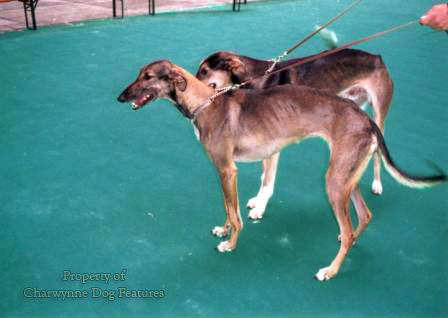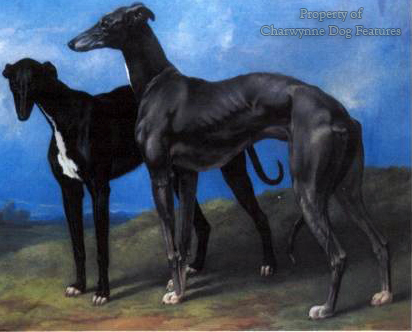732 JUDGING SIGHTHOUNDS
JUDGING THE SIGHTHOUNDS
by David Hancock
 “To judge a breed by working-type standards involves a deep knowledge of its particular purpose in the canine world, be it to follow a line of scent and tenderly retrieve game, or to point and set the position of game unseen, or to face and set a fox or badger in his den, or to match the speed and nimbleness of a hare until it escapes from sight. Each of these functions requires and calls for special physical and mental faculties with which the appropriate breed is naturally endowed.”
“To judge a breed by working-type standards involves a deep knowledge of its particular purpose in the canine world, be it to follow a line of scent and tenderly retrieve game, or to point and set the position of game unseen, or to face and set a fox or badger in his den, or to match the speed and nimbleness of a hare until it escapes from sight. Each of these functions requires and calls for special physical and mental faculties with which the appropriate breed is naturally endowed.”
Those wise observations by H. Edwards Clarke in his book The Greyhound of fifty years ago, should be engraved on the thinking of not just sighthound judges but those who appoint them. Fitness for function may be a new Kennel Club cry but, in the world of the sporting dog, it has always been the ultimate judgement.
The sighthound breeds at dog shows are not always the best ‘showers’; most of them resent such immodest blatant exhibitionism, as they might see it, preferring activity and expecting to be judged on performance not pushiness. Judges who know such breeds usually acknowledge this, although many lurcher judges at country shows lack the experience to see past this group-reluctance to perform artificially. Assessing any breed of dog in a ring is always going to be a combination of judgement, ideally objective, knowledge, and a technique. Sadly far too many judges that I see appear to base their decisions on 'gut-feeling' or by taking a shine to a particular dog on the day, or concentrating on fad breed points. One sighthound judge at Crufts in 2010 reported: “When I first judged Salukis in 1966 one could see all the characteristics that govern Salukis. Now it is difficult to find the ruff, the long tails, the bright oval eye, the dignified gentle expression and the unique shaped foot.” Would such details matter to a Bedouin hunter? Only as an afterthought did this judge add: “Some movement leaves a lot to be desired.” Now that would bother the Bedouin hunter!
A judge with knowledge is always going to triumph over one just hoping to get his decisions right. A judge with a technique is more likely than any other one to make sound decisions. Fanciers who pay money to enter a ring and travel a long way to get there deserve a competent judge. But time and time again, especially at lurcher and terrier shows, I watch judges at work in the ring, who apply a different sequence to each exhibit, only check one aspect of movement and fail even to examine some parts of the dogs' anatomy. I don't believe that their judgements are subsequently soundly based. In any field of human activity knowledge applied through a tried and tested technique will surpass 'gut-instinct' every time.
Far too many exhibitors at country shows expect the judge to see merit in their entry when they themselves have done little to prepare the exhibit for the ring. Some terriers and many gundogs are natural show-offs, most sighthounds are not. Dogs need to be schooled for the ring - not slavishly prepared, but trained to walk briskly on the lead and stand still during closer scrutiny. A future judge's examination of the bite is made easier by previous rehearsal. Why should your dog unquestioningly allow a complete stranger to look inside its mouth? But jaw construction really does matter and a competent judge will always want to check this important feature of a sporting dog. The judge can better apply his judging technique if the exhibitor's ring technique has been practised and the exhibit rehearsed. This can significantly affect placings.
The most valuable purpose for me in showing dogs in any ring is to identify future breeding material. The most important factor for me is: could this dog carry out its breed function? We all like a handsome dog but handsome unsound dogs, sadly, do win. I attended the 2003 World Dog Show in Dortmund and spent several days at the show. I have never seen so many unsound dogs under one roof in my entire life; some of them won prizes! Sportsmen expect their dogs to function. This capability is so much more important than beauty or breed type, the latter originating in function, but is so regularly betrayed by human whim. Hounds of all types, sighthounds especially, must never be judged on cosmetic appeal but on their anatomy's ability to carry through their function. Those breeding for flashy markings beware!
Fault judging is no help to anyone, breeder, owner, the status of the show, the sport of showing itself. Overseas they often list faults according to their seriousness, i.e. from disqualifying ones down to merely undesirable ones. No sighthound should ever win in the ring if it features upright shoulders, short upper arms, a weak neck or loins, poor feet, a short body (especially with a long back) or shoulder blades which touch when the dog stoops to put its nose to the ground. There is no such thing as the perfect dog; it's vital to judge the whole dog, not descending on the animal, oozing praise just because it's in superlative condition, has powerful hindquarters or a superb head. The sporting dog needs every part of its body to be sound! In KC show rings far too many breeds are judged solely on their heads or their coats or their flashy gait. Far too many judges ignore poor condition in the entry before them. 
In his informative "The Practical Guide to Showing Dogs" of 1956, Captain Portman-Graham wrote: "The fact that a dog is structurally sound is not in itself sufficient to ensure that it will always win at shows. It is of paramount importance that it must be...at the highest standard of condition...Perhaps one of the biggest advantages which dog showing confers on the dog as an animal is the care which must be bestowed upon it." If unfit dogs with poor muscular condition can win at dog shows, then the whole argument that such shows improve dogs is totally destroyed. Dogs which are inadequately exercised and merely wheeled out for the next show can be so easily identified by any competent judge and quickly thrown out of the ring that such an insidious practice, both for dogs and the dog game, can be ended. Sighthounds are first and foremost hunting dogs.
Portman-Graham went on to write: "...exercise is a vital consideration in maintaining any breed of show dog in bloom, health and vigour...When one watches the beautiful muscles of a racehorse one sees a similarity between a dog's muscles which have been developed correctly and naturally, and ripple in movement.” Yet there is evidence of lack of muscular tone and development in so many sighthound rings, even at many lurcher shows today. One of the saddest sights at a pedigree dog show has to be an unfit under-muscled unexercised exhibit from a sighthound breed; these dogs were born to run!
Movement demonstrates soundness, or reveals flawed physiques; the initial overall appraisal can reveal symmetry and allow assessment of the whole dog. The closer hands-on examination allows the slope of shoulder, the strength of loin, the muscular development, the skeletal frame and the construction of the jaw to be checked. But the sequence of the examination is crucial. For me, it is logical to view the whole dog standing and moving before a closer look is given. And by moving I mean three dimensional: going away, going across and then heading directly for me. I am seeking effortless locomotion, a balanced harmonious economical gait and no excessive action, either to the side or off the ground. Does the dog look as though it could go on like this for miles?
Any closer examination has, for me, to follow a set sequence: head, jaw, eyes and ears, neck and shoulders together, back and loins together, set of tail and pelvic slope together. Then to the lower case: spread and elbows together, front legs AND feet, thorax and tuck-up, hind-limbs AND feet then coat and character. Judging character isn't straightforward; I go for the look in the eye, the tail action and the confident body language. We all surely want keen willing up-on-their-toes sporting dogs. Without a set sequence I'd be worried I'd miss something. In the end, of course, what the dog can do will always be more important than what it looks like. But sound construction, backed by physical fitness, will always allow a sporting dog to excel and that is the task of every sighthound judge: to reward soundness and fitness for function, not showiness. Winning show-dogs get bred from; but, truly, who is honestly proud of a kennel full of incapable exhibitionists, useless show-offs!